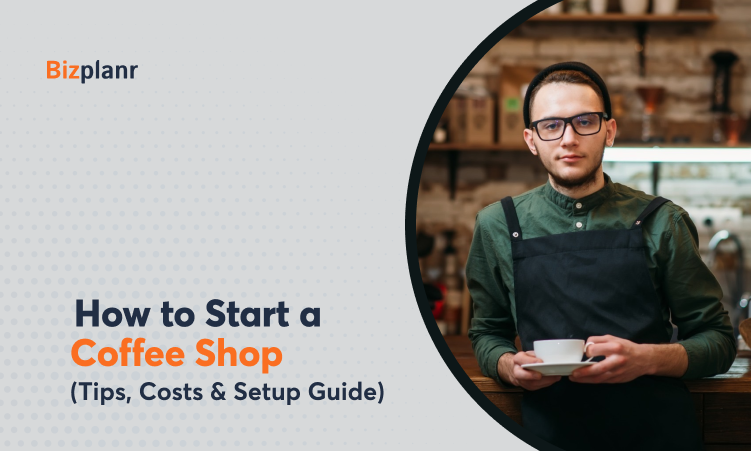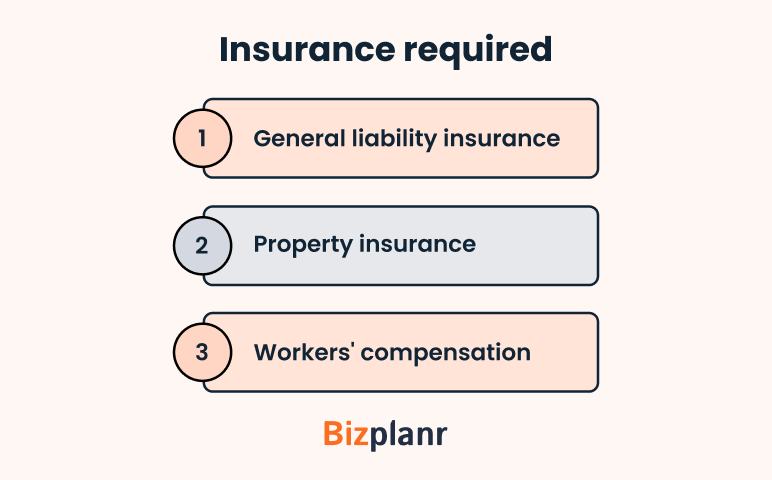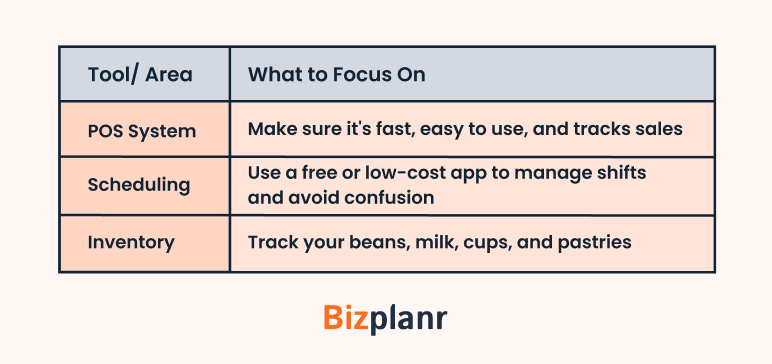Wondering how to start a coffee shop (on a low budget)?
Coffee is part of daily life for over 73% of Americans, so demand is steady, but running a shop takes more than great beans.
This guide breaks down from picking your shop’s vibe to writing a business plan, dealing with permits, hiring staff, and avoiding mistakes. We’ve got it all.
Bonus: We'll also go through the real costs (think over $60K–$300K 💰 depending on setup), so you're ready for what it actually takes.
Alright, let’s get into it.
Key Takeaways
- Startup costs range from $60,000 to over $400,000, depending on your setup and location.
- Choosing the right format (cart, kiosk, sit-down) affects your startup cost, staffing needs, and daily operations.
- Start simple: Focus on quality coffee, a lean menu, and smooth operations.
- This guide covers every step, from planning and permits to hiring, setup, and launch.
Step 1: Decide what kind of coffee shop you want to open
Before anything else, think about the kind of coffee shop you want to run. Do you picture a cozy space with people working on laptops, or something fast-paced like a walk-up window? Your vision for the cafe matters, but so does your budget and setup.
Here are a few formats to consider:
- Sit-down cafe: Think tables, chairs, Wi-Fi, and a menu that goes beyond espresso. This is great if you want a place for people to hang out, but it requires more space, more staff, and a higher budget.
- Kiosk or takeaway counter: Smaller footprint, faster pace, and less overhead. Works well in malls, train stations, or busy streets.
- Mobile coffee cart: You can set this up at events, parks, or office areas. It’s flexible and much cheaper to start, especially if you’re working solo.
- Drive-thru: Convenient and profitable if you find the right location, but startup costs (and permits) tend to be higher.
If you’re working with around $20,000 and plan to be hands-on, a mobile cart or compact cafe setup might make more sense than a 30-seat shop. Match your idea with what you can realistically manage. It’s better to start smaller and grow than overcommit and burn out early.
Once you’ve nailed this, the rest of the planning gets much easier.
Step 2: Research your local coffee market
Before you start ordering cafe equipment, do some local market research. Visit at least 3 to 5 local coffee shops near where you plan to open. Go during the morning rush and again in the afternoon. Watch what’s happening.
Who’s walking in?
Are they regulars?
What are they ordering?
Are people grabbing and going or sticking around?
Additionally, use Google Maps and Yelp to check reviews. Look for consistent praise and complaints. Is one place always praised for fast service while another gets knocked for being overpriced? These little clues matter.
Observe the foot traffic during peak hours and note how many people actually enter the shop. If the area is consistently busy and surrounded by schools or offices, it could be a strong location for your business.
And lastly, pay attention to menus, prices, and what’s always selling out. If three cafes offer pour-overs but none serve matcha or cold brew, maybe there’s a gap. This is your chance to spot what’s working and what’s missing, before you enter the space.
Step 3: Write your business plan
Now it’s time to pull your ideas together into a simple business plan. You’re not writing a pitch for investors (unless you need funding). This plan is for you to stay clear, focused, and ready.
Cover the basics:
| Business Planning Basics | Questions to Answer |
|---|---|
| Products Offered | What are you selling? (Coffee, tea, pastries, maybe sandwiches?) |
| Shop Type | What kind of shop is it? (Cart, sit-down café, takeaway counter?) |
| Startup Costs | How much will it cost to open? (List out equipment, rent, licenses, and coffee consumables.) |
| Pricing Strategy | What's your pricing? (Look back at your market research.) |
| Bean Sourcing | Where are you sourcing your beans? (Local roaster? Direct import?) |
| Marketing & Promotion | How will people find you? (Local flyers, social media, word-of-mouth?) |
Also, map out your startup costs plus at least 3 months of expenses. Rent, supplies, staff (if any), and some buffer for off weeks. Having a rough budget can save a lot of time in the long run.
Need help putting it together?
Our AI-powered tool helps you generate a detailed business plan—fast and easy.
Step 4: Handle legal setup
Once you’ve decided on your concept and location, it’s time to get your business legally set up. This part can feel a bit daunting, but it’s important to get it right from the beginning.
Start with the basics:
- Choose a business structure: For most small coffee shops, an LLC (Limited Liability Company) makes the most sense. It protects your personal assets and keeps paperwork simple.
- Register your business name: Check with your state to make sure your shop name is available, then officially register it.
- Apply for an EIN: Get your Employer Identification Number from the IRS (free and done online). You’ll need this to pay taxes and hire staff.
- Open a business bank account: Keep your finances separate from day one; it’ll save you a lot of confusion later.
Don’t forget about permits. Selling food and drinks means health codes apply. You’ll need:
- Local approval from your city or county
- A passing grade on your health inspection
- Proof that your location fits within zoning rules for food service
Step 5: Choose the right location
A beautiful corner shop with no foot traffic won’t pay the bills. It’s better to choose a less flashy space in a busier spot than a stunning one no one walks by. Before signing any lease, do a quick checklist of the location.
Start by visiting each potential spot at different times of day, especially during morning coffee hours. Is it buzzing with people heading to work or school?
Next, look around. Are there nearby offices, schools, gyms, or apartment buildings that could bring in steady, regular customers? Talk to neighboring shop owners and ask about the area’s foot traffic.
Parking matters more than you think. Can customers pull in easily, or is it a headache? If there’s no parking, is there solid public transport access?
Now crunch the numbers. Make sure the rent makes sense for your expected revenue. A gorgeous space that eats half your income in rent will strain your business from day one.
Lastly, consider the layout. Is there room for a few tables if you want seating? Can customers line up without blocking the door? Don’t get distracted by looks alone; go for a space that works, flows, and helps your coffee shop grow.
Step 6: Get licenses, permits, and insurance
This part isn’t optional; it’s required by law. Every coffee shop needs the right documents in place to operate safely and legally.
Here’s what you’ll likely need:
- Business license (from your city or county)
- Food service permit
- Health inspection approval
- Seller’s permit (if you’ll sell merchandise or packaged goods)
- Food handler certification (for you and your staff)
Don’t forget insurance. You’ll need:
- General liability insurance – covers accidents like slips and falls
- Property insurance – protects your equipment and furnishings
- Workers’ compensation – required if you’re hiring employees
Handling these early avoids future mishappenings. Talk to your local health department and a business insurance agent so you’re not missing anything. Once this is done, you’re one step closer to opening your doors.
Step 7: Plan your menu and suppliers
Start with a simple menu. You don’t need 40 drink options to impress people. Stick to what works:
- Espresso drinks (latte, cappuccino, americano)
- Drip coffee or pour-over
- Optional: a few syrups, alternative milks, and one or two seasonal specials
Add food only if you can handle it. A few pastries or pre-made snacks are fine, but full breakfast menus require more staff, permits, and prep space. Focus on the coffee first. You can expand later.
Next, think about your coffee beans. You have two options:
- Local roasters: Usually more expensive, but better quality and faster delivery. Also gives you a local story to tell.
- Wholesale suppliers: Often cheaper and easier to scale with, but make sure the quality still meets your standards.
Now, onto equipment. Here’s a rough list of what you’ll need to get started, along with price estimates:
| Item | Cost Range |
|---|---|
| Espresso machine | $3,000 – $10,000+ |
| Commercial grinder | $800 – $2,000 |
| Drip brewer | $500 – $2,000 |
| Refrigeration unit | $1,000 – $3,000 |
| POS system | $500+ (plus monthly fees) |
| Furniture (sit-down setup) | $2,000 – $5,000 |
Step 8: Hire and set up operations
Even if you plan to be hands-on, you can’t run a shop entirely alone forever. At the very least, you’ll need one or two part-time baristas to help cover shifts, weekends, or peak hours.
When hiring, look for:
- People who are reliable and consistent
- Good with customers (even more important than coffee skills, you can train the rest)
- Comfortable with multitasking in a fast-paced environment
Once your team is in place, focus on setting up simple systems. Nothing too fancy, just enough to keep things running smoothly:
Good operations = fewer daily headaches.
Set things up now so you’re not suffering later. When your systems run smoothly, everything else, like service, speed, and quality, falls into place.
Step 9: Prepare for launch
You might not need a grand ribbon-cutting ceremony, but you do need to be ready. Launch week is your chance to catch and fix issues before real customers walk in.
Here’s what to do:
- Run soft opens: Make drinks for friends, family, or friendly neighbors
- Test your equipment: Does the espresso machine hold up during busy times? Does the POS system freeze?
- Time each drink: How long does it take to make a cappuccino during a rush?
- Watch what breaks down: Does the register slow you down? Is the fridge in the wrong spot? Are you constantly running out of milk?
Doing so helps you find problems while the stakes are low. Keep things relaxed, take notes, and make small adjustments.
Always remember, a smooth launch doesn’t happen by luck; it’s the result of preparation. Treat this step seriously, and your real opening will feel a lot less stressful.
Step 10: Track your numbers and make changes fast
Opening day isn’t the finish line; it’s the start of a new job. Once the shop is running, your focus should shift to watching the numbers and making small, smart adjustments.
Here’s what to pay attention to:
- What sells the most? (Is everyone ordering cold brew? Maybe you need a second batch brewer.)
- When are you busiest? (Are weekends slow? Is 7–9 AM packed? Adjust your staffing and hours.)
- What’s not moving? (Cut slow sellers and rotate new drinks in.)
Don’t get too attached to your first plan. It’s a starting point, not a blueprint. If people complain that the space feels cramped or the line moves slowly, listen.
Getting feedback is always gold. Update your menu, rearrange the counter, and try new specials.
The best coffee shops aren’t static; they evolve.
4 Mistakes to avoid (and what to do instead)
Here are some common missteps new owners make that are avoidable. Awareness is key.
1. Signing a lease without understanding foot traffic
Fix: Spend time observing the area at different times of day, especially mornings and weekends. A beautiful space won’t help if no one walks by. Great coffee needs great visibility.
2. Offering too many items on the menu (that too soon)
Fix: Start with a focused, quality-first menu. Find your core favorites (like 3–4 signature drinks and 1–2 snacks) and build from there. It’s easier on your staff, supply chain, and budget.
3. Underpricing your drinks
Fix: Price based on your costs, not just what others are charging. Specialty coffee has value; don’t train your customers to expect it to be cheap. Quality service, great ingredients, and ambiance all add up.
4. Neglecting the small details (like cleanliness)
Fix: Customers notice! Clean spaces feel safer and more welcoming, and they drive repeat business. Make cleanliness part of your daily rhythm, not an afterthought.
Conclusion
Starting a coffee shop is exciting, but let’s be real, it’s also a lot. From choosing beans and equipment to finding the right space and getting your pricing right, there’s a learning curve.
But that’s all part of it. You figure things out as you go. You adjust. You get better.
One thing that helps? Having a simple plan from the start. Nothing fancy, just something clear to keep you on track. A tool like Bizplanr can make that part way easier. It helps you lay everything out, so you're not scrambling later.
Keep things simple, stay consistent, and remember why you started. That first happy customer sipping your coffee? Worth it.
Get Your Business Plan Ready In Minutes
Answer a few questions, and AI will generate a detailed business plan.
Frequently Asked Questions
How much does it cost to open a small coffee shop?
The average cost to open a single coffee shop with seating typically ranges from $80,000 to $300,000. If you're starting with a coffee cart, kiosk, or food truck, the costs are lower, starting around $60,000.
On the higher end, if you plan to include both seating and a drive-thru, expenses can exceed $300,000, depending on location, equipment, and build-out needs.
Do I need a license or permit to sell coffee?
Yes, you’ll need a business license, a food service permit, health inspection approval, and possibly a seller’s permit (if you sell merch or packaged items). Your city or county will have a list of what’s required.
What equipment do I need to start a coffee shop?
At minimum, you'll need:
- Espresso machine ($3,000–$10,000+)
- Grinder ($800–$2,000)
- Drip brewer ($500–$2,000)
- Fridge ($1,000–$3,000)
- POS system ($500+ plus software fees)
- Furniture (if dine-in, around $2,000–$5,000)
Expect to spend $10,000–$20,000 on basic equipment for a small setup.
How many staff members do I need to run a coffee shop?
For a small shop, 1–2 part-time baristas, plus you can work along. As customer flow grows, you’ll likely need at least 3–5 staff members to rotate shifts and cover peak hours.
How can I attract customers to a new coffee shop?
Start with the basics, serve great coffee, keep your service quick, and make sure your space is clean and welcoming. Then, spread the word through:
- Local marketing (flyers, community boards)
- Google Maps listing (so people can find you)
- Social media (share photos, updates, behind-the-scenes)
- Soft launch events (invite locals to try it out)
- Loyalty cards (give people a reason to return)
Word-of-mouth grows fast when people have a good first experience.







